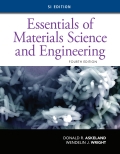
(a)
Interpretation:
The density of the given sample lead (Pb) is to be determined.
Concept introduction:
The relationship between the theoretical density
Here,
Volume of a unit cell
(b)
Interpretation:
The number of vacancies per gram of lead is to be calculated for the given sample.
Concept introduction:
Density
Here,
Trending nowThis is a popular solution!

Chapter 4 Solutions
Essentials of Materials Science and Engineering, SI Edition
- Law of Sines Solve the following problems using the Law of Sin 7. Find side x. All dimensions are in inches. -°-67°-37° 81° x Sin A 8.820 X 67°00' 32°00' a sin A b C sin B sin Carrow_forward12.3 Express each of the waveforms in Fig. P12.3 (on page667) in terms of step functions and then determine its Laplacetransform. [Recall that the ramp function is related to thestep function by r(t − T) = (t − T) u(t − T).] Assume that allwaveforms are zero for t < 0.arrow_forwardhow to read log logsarrow_forward
- The point quadtree and the kd-tree are two data structures that generalize the binary search tree and are used to store multi-dimensional keys, such as points in k-dimensional space. For this assignment, however, we will limit our implementations to points in two-dimensional space though the extension to higher dimensions is quite straightforward Requirements 1. Implement the class Point for two-dimensional points. Include appropriate getters and setters (or properties). 2. Implement classes PointQuadtree and KDTree. a. Select an appropriate data structure b. // Insert point p // Assume that duplicate points are not inserted // Return true if successful; false otherwise public bool Insert(Point p) Note: Unlike the handout, assume that all points are not known beforehand. Therefore, no pre-processing is done to help balance the tree. c. // Delete point p // Returns true if successful; false otherwise public bool Delete(Point p) c. // Return true if point p is found; false otherwise…arrow_forward35. a. Determine B. b. Determine side b. c. Determine side c. 5.330 in.- ZB 73°30'arrow_forwardProblem 2: Use the table below to compute the coordinates of the centroid of area shown below. y – 3 in.—|— 4 in. - -3 3 in. 3 in. x Area X X * Area y Y * Area Component (in²) (in) (in³) (in) (in³) Square 1 Rectangle 2 Triangle 3 Rectangle 4 Σarrow_forward
- Consider a 12 cm internal diameter, 14 m long circular duct whose interior surface is wet. The duct is to be dried by forcing dry air at 1 atm and 15 degrees C throught it at an average velocity of 3m/s. The duct passes through a chilled roo, and it remains at an average temp of 15 degrees C at all time. Determine the mass transfer coeeficient in the duct.arrow_forwardDiscrete Mathematics for Computer Engineeringarrow_forwardQuestion 1 - Array Iterators Like the JS on A2, there is no visual component to this question. The HTML really just needs to load the JavaScript, everything else will output to the console. The JS file should the completion of the task, and all necessary testing, so that just loading the file will complete the task with enough different inputs to ensure it works. Even Numbers [3 marks] Create a function that determines if a provided number is even. Define an array of numbers, then on the array use the appropriate array iterator to determine if the array contains only even numbers using the function you defined. Output the results, and test with several arrays. Long Names [3 marks] Define an array of names. Use an iterator to retrieve a new array containing only the names longer then 12 characters. Your iterator should be passed an anonymous arrow function. Test with several different arrays First Names [3 marks] Define an array called fullNames that contains 7 javascript objects of…arrow_forward
- note n=number of link(dont include the ground link (fixed))arrow_forwardplease answer everything correctly , include comments etc and show me outputs as well, make sure eevrything is done well ,the image is the first page before the questions, note: this module is machine learning 700 Question One Predicting House Prices using Real Estate Data (25 Marks) 25 Marks A real estate company, UrbanNest Realty, wants to improve its property pricing strategy. Traditional valuation methods often lead to mispricing, affecting revenue and customer satisfaction. The company aims to use machine learning to predict house prices more accurately. Dataset: California Housing Prices from sklearn.datasets (a) Load the dataset and perform basic exploratory data analysis (EDA) by displaying summary statistics, handling missing values, and visualizing key features. (6 Marks) (b) Train a Linear Regression and a Decision Tree Regressor to predict house prices. Evaluate the models using Mean Absolute Error (MAE) and R² Score. (12 Marks) (c) Interpret the model performances…arrow_forwardDiscrete Mathematics for Computer Engineeringarrow_forward
 MATLAB: An Introduction with ApplicationsEngineeringISBN:9781119256830Author:Amos GilatPublisher:John Wiley & Sons Inc
MATLAB: An Introduction with ApplicationsEngineeringISBN:9781119256830Author:Amos GilatPublisher:John Wiley & Sons Inc Essentials Of Materials Science And EngineeringEngineeringISBN:9781337385497Author:WRIGHT, Wendelin J.Publisher:Cengage,
Essentials Of Materials Science And EngineeringEngineeringISBN:9781337385497Author:WRIGHT, Wendelin J.Publisher:Cengage, Industrial Motor ControlEngineeringISBN:9781133691808Author:Stephen HermanPublisher:Cengage Learning
Industrial Motor ControlEngineeringISBN:9781133691808Author:Stephen HermanPublisher:Cengage Learning Basics Of Engineering EconomyEngineeringISBN:9780073376356Author:Leland Blank, Anthony TarquinPublisher:MCGRAW-HILL HIGHER EDUCATION
Basics Of Engineering EconomyEngineeringISBN:9780073376356Author:Leland Blank, Anthony TarquinPublisher:MCGRAW-HILL HIGHER EDUCATION Structural Steel Design (6th Edition)EngineeringISBN:9780134589657Author:Jack C. McCormac, Stephen F. CsernakPublisher:PEARSON
Structural Steel Design (6th Edition)EngineeringISBN:9780134589657Author:Jack C. McCormac, Stephen F. CsernakPublisher:PEARSON Fundamentals of Materials Science and Engineering...EngineeringISBN:9781119175483Author:William D. Callister Jr., David G. RethwischPublisher:WILEY
Fundamentals of Materials Science and Engineering...EngineeringISBN:9781119175483Author:William D. Callister Jr., David G. RethwischPublisher:WILEY





